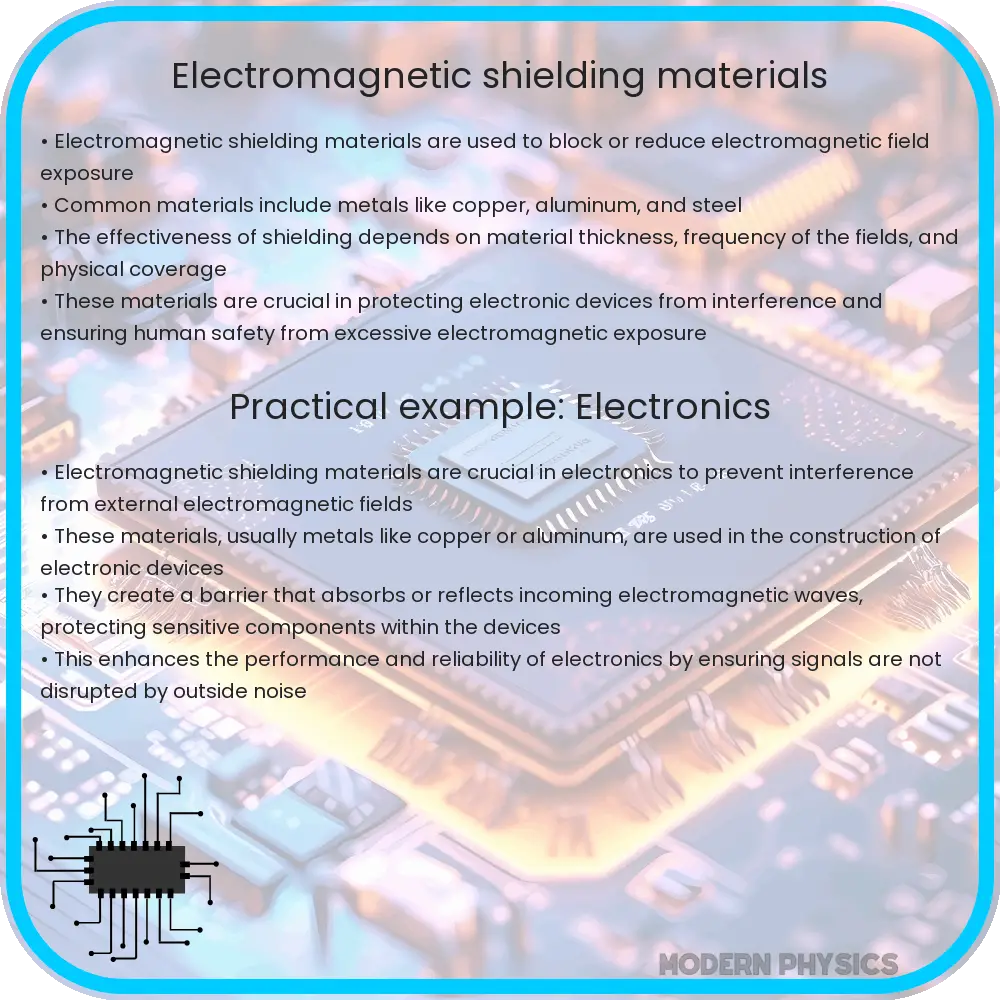Learn about electromagnetic shielding materials, their types, functionality, and applications across various industries to protect sensitive electronics from EMI.

Understanding Electromagnetic Shielding Materials
Electromagnetic shielding is a process used to block or reduce electromagnetic fields within a space by using barrier made of conductive or magnetic materials. Commonly used in various industries such as electronics, aerospace, and telecommunications, effective shielding is crucial for protecting sensitive electronic equipment from electromagnetic interference (EMI) while also preventing the emission of electromagnetic waves that may disrupt other devices.
Types of Electromagnetic Shielding Materials
The effectiveness of electromagnetic shielding materials depends on the material’s ability to absorb or reflect electromagnetic radiation. There are primarily three types of materials used for shielding:
- Conductive Materials: Metals like copper, aluminum, and brass are widely used due to their high electrical conductivity. These materials primarily reflect electromagnetic waves, thereby preventing them from reaching the shielded equipment.
- Magnetic Materials: Materials such as ferrites and silicon steel are used to absorb electromagnetic waves, particularly effective at low frequencies. These materials are often used in conjunction with conductive materials to enhance the shielding effectiveness.
- Composite Materials: Composites combine conductive and magnetic materials and sometimes include non-metallic elements to provide lightweight and flexible options for electromagnetic shielding. They are typically used in applications requiring a combination of efficient shielding and reduced weight or bulk.
How Shielding Materials Work
The primary principle behind electromagnetic shielding is the reflection and absorption of the electromagnetic waves. The effectiveness of a shielding material is influenced by factors such as the material’s thickness, conductivity, and magnetic permeability. The shielding effectiveness (SE) of a material can be expressed as:
SE (dB) = 20 * log10[V0 / Vs]
where V0 represents the incident voltage of the electromagnetic wave and Vs is the voltage after the wave passes through the shield. A higher value in decibels (dB) indicates better shielding efficiency.
In practical applications, conductive materials are often used to reflect the electric component of the electromagnetic wave, while magnetic materials are used to absorb the magnetic component. The use of multiple layers of different materials can enhance overall shielding performance by creating multiple reflection and absorption barriers for electromagnetic waves.
Industry Applications of Electromagnetic Shielding
Electromagnetic shielding materials are utilized in a variety of settings:
- Consumer Electronics: Devices like smartphones, laptops, and televisions incorporate shielding to prevent interference from external electromagnetic fields and reduce emissions that could influence other devices.
- Medical Equipment: Shielding is crucial in medical settings to protect sensitive equipment such as MRI machines and patient monitoring systems from EMI, which could result in inaccurate readings or malfunctioning.
- Aerospace: Aircraft and spacecraft are equipped with electromagnetic shields to protect navigation and communication systems from the intense electromagnetic environments encountered during flight and space missions.
- Military: Military applications include shielding for communication equipment and electronic countermeasure systems to ensure reliable operation in environments with potential electromagnetic interference.
The use of electromagnetic shielding materials is not only essential for the functionality and longevity of electronic equipment but also plays a critical role in maintaining the safety and reliability of many types of systems in various sectors.
Challenges and Future Directions in Electromagnetic Shielding
Despite the advancements in electromagnetic shielding materials and technologies, there are several challenges that researchers and engineers continue to face:
- Material Cost and Availability: High-quality shielding materials, especially those involving rare or complex composites, can be expensive and difficult to procure, impacting the overall cost of manufacturing electronic devices.
- Increasing Frequency Spectrum: As technology advances, devices operate at higher frequencies, requiring shielding materials that can effectively block or absorb these higher frequency waves. Developing materials that provide effective shielding at these frequencies is an ongoing challenge.
- Weight and Flexibility: For applications such as aerospace and portable consumer electronics, the weight and flexibility of shielding materials are crucial factors. Engineers must balance effective shielding with the need for lightweight and flexible materials.
- Environmental Concerns: The production and disposal of some shielding materials can have adverse environmental impacts. Developing eco-friendly shielding materials that do not compromise on performance is a significant area of research.
Future research in electromagnetic shielding is likely to focus on the development of new materials and composites that address these challenges. Innovations may include nanomaterials, which offer high conductivity and magnetic permeability with reduced weight, and new polymer-based composites that are both effective and environmentally friendly.
Conclusion
Electromagnetic shielding is a critical technology that spans many industries, protecting electronic devices and systems from interference and ensuring their correct operation. The materials used for electromagnetic shielding vary in composition and application but are united by their ability to either reflect or absorb electromagnetic waves effectively. As technology continues to evolve, the development of new and improved shielding materials will remain essential to safeguard the increasing complexity of electronic systems against electromagnetic interference. Understanding the basic principles, current materials used, and the challenges faced helps us appreciate the intricacies and importance of electromagnetic shielding in our modern world.
